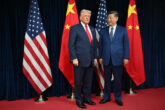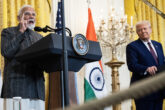December 27, 2019
The U.S.-Chinese Trade War Just Entered Phase 2
The Trump administration’s “phase one” trade deal with China may mark the end of the first chapter of the trade conflict between the United States and China, which saw Washington embrace a confrontational approach. But even if China meets its commitments under that agreement, the deal will not mean the conclusion of the broader competition between the two powers. The forces of geopolitical rivalry and the sharp differences between China’s state capitalist model of economic development and the U.S. economic system are too great. Instead, the deal will mark a pivot to a second phase of economic competition, one which will be fought with export and import controls, investment restrictions, and sanctions rather than with tariffs.
Over the past two years, Washington has been quietly building a legal and regulatory architecture for this campaign. In 2018, U.S. Congress enacted legislation to enhance controls on the export of emerging technologies, such as advanced robotics and artificial intelligence, and bolster reviews of foreign investment in the United States. In November 2019, the Trump administration and Congress took steps to block U.S. companies from using Chinese telecommunications network equipment in the United States. There is increasing discussion in Washington about additional restrictions on business and investment relations between the United States and China, such as limits on federal employee retirement fund investments in China.
Read the full article in Foreign Policy.
More from CNAS
-
Indo-Pacific Security / Energy, Economics & Security
How to Win the Economic War with ChinaTrump's approach to China has run aground, giving Beijing unprecedented advantage in the economic conflict....
By Edward Fishman & Julian Gewirtz
-
America’s Self-Loathing Is a Losing Hand
This article was originally published in The Washington Post.Around 10 years ago, the United States began a historic shift in its grand strategy toward China, abandoning the b...
By David Feith
-
Indo-Pacific Security / Energy, Economics & Security / Technology & National Security
Selling AI Chips Won’t Keep China Hooked on U.S. TechnologyU.S. policy should not rest on the illusion that selling chips can trap China inside the American tech ecosystem....
By Janet Egan
-
Will New Delhi-Beijing Move Beyond Friction Points? | Ex-White Official On India-China Reset
Prime Minister Narendra Modi on Friday said that India and China, as two major economies, must work together to bring stability to the global economic order. NDTV's Gaurie Dwi...
By Lisa Curtis




